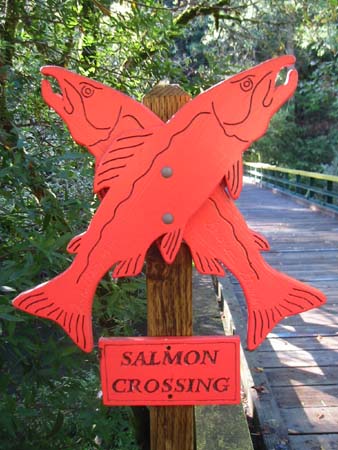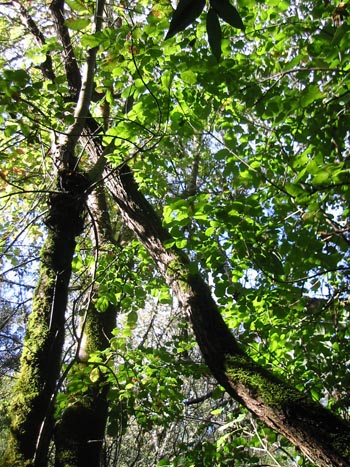 November rain sings a song of connectivity. It completes the natural cycle, raising the rivers and recharging the aquifers, pouring from the air to the earth and back to the ocean whence it came. We find an extraordinary example of its ramifications in western Marin County, where the rainfall not only paints a fresh coat of green on the sun-blasted hills but also summons a legion of deep sea creatures to return to the highland haunts of their birth.
November rain sings a song of connectivity. It completes the natural cycle, raising the rivers and recharging the aquifers, pouring from the air to the earth and back to the ocean whence it came. We find an extraordinary example of its ramifications in western Marin County, where the rainfall not only paints a fresh coat of green on the sun-blasted hills but also summons a legion of deep sea creatures to return to the highland haunts of their birth.
The Lagunitas Creek watershed begins on the northern slopes of Mount Tamalpais and flows on the landward side of the Bolinas Ridge approximately 25 miles north to drain into Tomales Bay, fed by numerous streams along the way including Nicasio Creek, San Geronimo Creek, Olema Creek, Devil's Gulch and Deadman's Gulch. At more than 100 square miles, it is the largest watershed in Marin County, but its stature stands all the higher for the abundance of life it supports.
The riparian plant community here exists in layers of height-based competition for sunlight. Redwoods, Douglas firs, California bays, and madrones reach for the sky, while beneath them willows, alders, big-leaf maples and dogwoods jockey for position in the increasingly dappled shade. Hazelnuts, huckleberries, and elk clover fill in the lower levels, adapted as they are to the darker conditions near the forest floor.
 One of the most beautiful trees in fall is the Oregon ash (Fraxinus latifolia), a deciduous species 50-70 feet tall. The distinctive pinnate leaves (usually 5-7 leaflets each) cling to their branches through the end of November, catching the filtered sunlight with a delicate glow.
One of the most beautiful trees in fall is the Oregon ash (Fraxinus latifolia), a deciduous species 50-70 feet tall. The distinctive pinnate leaves (usually 5-7 leaflets each) cling to their branches through the end of November, catching the filtered sunlight with a delicate glow.
More suitable species for the home gardener are the low-growing specimens that thrive in the shady understory of the trees. Consider redwood ivy (Vancouveria planipetala), a slow-growing rhizomatous groundcover with polished deep-green leaves that unfurl in the spring like fiddleheads and an unusual bloom of white-lavender "inside-out" flowers with turned-back petals. Another favorite is the five-finger fern (Adiantum aleuticum), distinctive for its hand-like array of "fingers" (often more than five per stalk) and delicate fan-shaped frond segments.
The deep shade of the forest keeps the waters of Lagunitas Creek cool and protected from the sun, which is good news for the anadromous fish who return here to spawn. Mature salmon and steelhead mark the onset of the November rains by leaving the ocean and swimming upstream into the freshwater creeks and streams of their youth. This lifecycle that embraces both fresh and saltwater ranks these fish among the most remarkable members of the animal kingdom.
Lagunitas Creek has lost some 90% of its breeding coho salmon population, from an estimated 6,000 annually before the 1950s down to currently around 500. Specific current impacts to the Lagunitas coho include losing 50% of their habitat to dams (mostly for reservoirs), sedimentation and destruction of riparian habitat from development, trampling of redds (nests) by humans and animals, pollution of streams, water diversion from creeks and withdrawal from reservoirs and groundwater wells, and the introduction of non-native fish like the large-mouth bass and the bluegill.
But the salmon that do return here are considered among the most robust runs in California, representing 10% of all wild California coho surviving today. These fish are now protected under the federal Endangered Species Act, so it is illegal to catch, harass, or disturb them. But the watershed offers several excellent viewing spots to see the salmon in action.
Roy's Pools, a series of man-made waterfalls, lie at the edge of the golf course on San Geronimo Valley Dr. near the intersection of Nicasio Valley Rd., approximately 5 miles west of Fairfax. This site is not signposted, with only a small wooden box of informational brochures labeled "SPAWN" (Salmon Protection and Watershed Network) to mark the spot. You can stand by the side of the road in the shade of a lovely tanbark oak and watch the salmon leap over the falls, or (for the more adventurous) sneak onto the golf course and stroll upstream to find the fish in their spawning grounds.
Easier to find is the Leo Cronin Viewing Area, just past the Shafter Bridge on Sir Francis Drake Blvd., at the confluence of San Geronimo Creek and Lagunitas Creek. A sign in the parking lot explains the complex lifecycles of salmon and steelhead -- how an egg becomes an alevin becomes a fry becomes a smolt becomes a fish -- which are the necessary stages of development in the adaptation from freshwater to the sea. If the bank of the stream below the parking lot is crowded with sightseers, walk the fire road upstream toward Peter's Dam and Kent Lake to find a more secluded spot.
Those willing to pay the $6 entrance fee at Samuel P. Taylor Park campground can find an even more peaceful spot to see the spawning fish. Try the site directly behind the headquarters building at the entrance, which is known as a popular spawning spot. Or follow the path downstream about a mile to the old mill site, for which this stream was once named Papermill Creek. (Sam Taylor made his first fortune in the gold fields, then opened a paper mill here and ultimately supplied newsprint, election ballots, brown bags, and other paper products to the growing city of San Francisco throughout the late 19th century.)
Every weekend from November 20 through mid-January, naturalists affiliated with SPAWN will lead creek walks to view steelhead and salmon at various sites in the watershed. The tours meet Saturdays and Sundays at 10 a.m. and 1 p.m. -- call (415) 488-0370 x102 to make a reservation (required), or visit www.spawnusa.org for more information.
Water conservation saves salmon -- all our best restoration efforts are for naught without sufficient water in the creek for the fish. Rainfall in the watershed is a finite resource; the more that goes to reservoirs for city consumption, and the more drained from streams for rural irrigation, the lower the creek will run that year. This is yet another reason for homeowners to consider ripping out their thirsty, impractical, high-maintenance lawns and to replace them with a landscape of drought-tolerant California natives, the plants that grew here before there was any such thing as a gardener.
November carries us from summer's siege into winter's wet embrace. The swollen river is an umbilicus between forest and sea. Cycles of water link our seasons and connect our metaphors. To paraphrase the poet -- if salmon come, can spring be far behind?
* * *
Madroño founder Geoffrey Coffey understands the forest better than the sea. Find him online by swimming upstream to www.geoffreycoffey.com.

